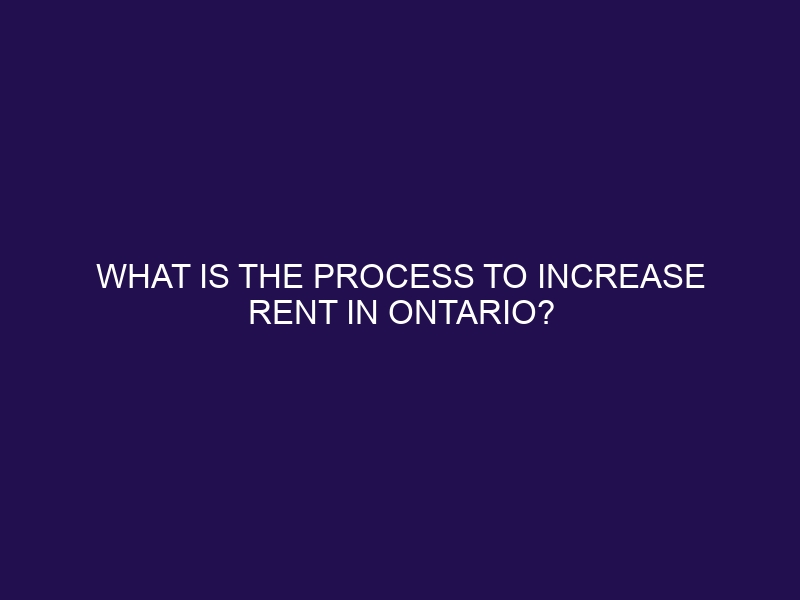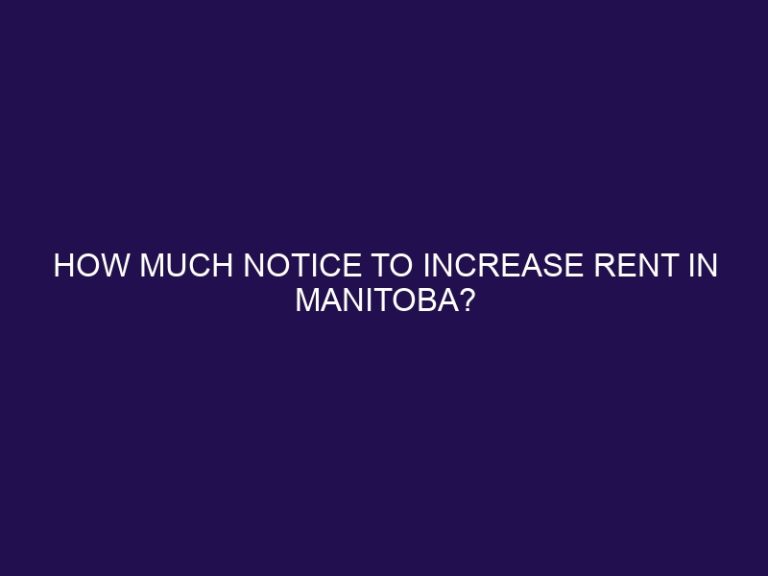What is the process to increase rent in Ontario?
.jpg)
Understanding the Legalities of Rent Increase
In Ontario, the process of increasing rent is regulated by the Residential Tenancies Act. This legislation outlines the rights and responsibilities of both landlords and tenants, ensuring a fair and transparent process. Familiarizing yourself with these legalities is essential before attempting to increase rent.
The Residential Tenancies Act in Ontario establishes guidelines for rent increases, stating that landlords can only raise the rent once every 12 months for existing tenants. There are specific regulations around the maximum percentage by which rent can be increased annually, which is determined by the government.
To increase rent in Ontario, landlords must follow a series of steps:
1. Review the current rental agreement to ensure that a rent increase is permissible.
2. Provide proper notice to tenants, notifying them of the upcoming rent increase.
3. Calculate the allowable rent increase based on the guidelines set by the government.
4. Complete the N1 form, which is the official document to notify tenants of the rent increase.
5. Serve the N1 form to tenants within the required timeframe and in the appropriate manner.
However, it’s important to note that tenants have the right to challenge the rent increase if they feel it is unreasonable. In such cases, a dispute resolution process is available through the Landlord and Tenant Board of Ontario.
Understanding the legal process and following the proper steps ensures that landlords and tenants are protected and that rent increases are conducted in a fair and lawful manner.
Key Takeaways:
- Knowing the legalities: Understanding the Residential Tenancies Act in Ontario and the rights and responsibilities of landlords and tenants is crucial when considering a rent increase.
- Proper notice and calculations: Landlords must review the current rental agreement, provide proper notice to tenants, and calculate the allowable rent increase before proceeding.
- Completing the necessary steps: Landlords should complete the N1 Form and serve it to tenants to officially increase the rent, following the prescribed steps and regulations outlined in Ontario.
Understanding the Legalities of Rent Increase
Understanding the legalities of rent increase in Ontario is essential for both tenants and landlords. In Ontario, the Residential Tenancies Act outlines the procedure that landlords must follow when it comes to increasing rent. Landlords are permitted to raise the rent only once every 12 months and they are required to provide tenants with a written notice at least 90 days in advance. The government sets an annual rent increase guideline, which limits the percentage by which landlords can raise rent. It is crucial for both parties to have a clear understanding of their rights and responsibilities to ensure a fair and lawful rental experience. If you have any questions or concerns about rent increases in Ontario, remember to seek legal advice.
What is the Residential Tenancies Act in Ontario?
The Residential Tenancies Act in Ontario, also known as the RTA, is a crucial piece of legislation that governs the rights and responsibilities of both landlords and tenants. It outlines the legal framework for rental agreements and provides guidelines for various aspects of renting, including rent increases, evictions, and maintenance responsibilities. So, what is the Residential Tenancies Act in Ontario? Well, it sets out the rights of tenants, such as the right to a safe and habitable living environment, protection from unlawful eviction, and access to dispute resolution mechanisms. Meanwhile, landlords must comply with the act’s regulations, which include providing proper notice for rent increases and adhering to maximum allowable rent increase percentages set by the government. To ensure fair and lawful rental relationships, both landlords and tenants need to understand the Residential Tenancies Act in Ontario.
What are the Rights and Responsibilities of Landlords and Tenants?
- Landlord’s Responsibilities:
- Maintaining the property in a safe and habitable condition.
- Addressing repairs and maintenance promptly.
- Providing proper notice for entry into the rental unit.
- Respecting privacy rights of tenants.
- Following legal procedures for rent increases and evictions.
- Tenant’s Rights:
- Living in a safe and secure rental unit.
- Having reasonable enjoyment of the rental unit.
- Requesting necessary repairs and maintenance.
- Protection against discrimination and harassment.
- Privacy rights and freedom from unreasonable disturbances.
- Shared Responsibilities:
- Paying rent on time and in full.
- Abiding by the terms of the rental agreement.
- Providing proper notice before moving out.
- Using the rental unit responsibly and not causing damage.
- Respecting the rights and privacy of other tenants.
What are the Regulations around Rent Increases?
In Ontario, there are regulations in place regarding rent increases to protect both landlords and tenants. What are the Regulations around Rent Increases? According to the Residential Tenancies Act, landlords must provide proper notice to tenants before increasing the rent. The allowable rent increase is determined based on guidelines set by the government each year. Landlords must complete the N1 Form and serve it to the tenants to initiate the rent increase process. It is important to note that tenants have the right to challenge the rent increase if they disagree with it. The dispute resolution process can be followed to address any issues.
Fact: Did you know that in Ontario, rent increases are capped annually and are subject to government guidelines?
Steps to Increase Rent in Ontario
Looking to increase rent in Ontario? Discover the essential steps you need to know. We’ll dive into reviewing the current rental agreement, providing proper notice to tenants, calculating the allowable rent increase, completing the N1 form, and serving it to tenants. Stay tuned as we break down each step, ensuring you have the knowledge to navigate the process with confidence. Let’s get started on maximizing your rental income in Ontario!
Step 1: Reviewing the Current Rental Agreement
Step 1: When considering a rent increase in Ontario, it is crucial to first review the current rental agreement.
- Check the terms: Take the time to examine the rental agreement and understand the terms regarding rent increases.
- Notice requirements: Review the specified notice requirements in the agreement, including the time frame for providing notice to tenants.
- Lease terms: Gain an understanding of the lease’s length and any provisions related to rent increases during the lease term.
- Renewal options: Determine whether the lease includes an option for renewal and if there are any conditions or limitations concerning rent increases for renewed leases.
- Record keeping: To ensure compliance with legal requirements, maintain a record of all relevant information from the current rental agreement.
Step 2: Providing Proper Notice to Tenants
“`
- Check the rental agreement for any specific requirements regarding notice.
- Follow step 2: Providing Proper Notice to Tenants and determine the type of notice needed: Form N1 for an above guideline increase or Form N2 for an annual increase.
- Ensure the notice includes all required information, such as the reasons for the increase and the effective date.
- Deliver the notice to the tenant in person, by mail, or by email, depending on the agreed method of communication.
- Keep a record of when and how the notice was delivered.
| Fact: | In Ontario, for an annual rent increase, the notice must be provided at least 90 days before the effective date. |
|---|
Step 3: Calculating the Allowable Rent Increase
Calculating the allowable rent increase in Ontario involves several key steps:
- Start by reviewing the current rental agreement to determine if there are any restrictions or limitations on rent increases.
- Next, check the Residential Tenancies Act for the specific regulations surrounding rent increases in Ontario.
- Step 3: Calculating the Allowable Rent Increase using the formula provided by the Act, which takes into account factors such as inflation and local market trends.
- Complete the N1 form, which is used to officially notify tenants of the proposed rent increase.
- Serve the N1 form to tenants, ensuring it is done in accordance with the legal requirements for notice.
It’s important to consult with a legal professional or seek guidance from the Landlord and Tenant Board if you have any questions or concerns during this process.
Step 4: Completing the N1 Form
Completing the N1 form is an essential step when increasing rent in Ontario. Here’s a list of steps to follow:
- Download the N1 form from the Landlord and Tenant Board website.
- Fill out the required information, including the names and addresses of both the landlord and tenant, and the rental property details.
- Indicate the current rent amount and the proposed rent increase amount.
- Step 4: Complete the N1 form by explaining the reason for the rent increase, such as increased operating expenses or renovations.
- Attach any supporting documents, such as receipts or contractors’ quotes.
- Sign and date the form.
- Keep a copy for your records.
- Serve the N1 form to the tenant according to the proper legal methods.
John, a landlord in Ontario, recently decided to increase the rent for his tenant due to rising property taxes. He completed the N1 form accurately, attached the necessary documents, and served it to his tenant. The tenant understood the reason behind the rent increase and accepted it, leading to a smooth resolution between both parties.
Step 5: Serving the N1 Form to Tenants
- Ensure you have completed the N1 Form accurately, including all relevant details.
- Make copies of the completed N1 Form for yourself and each tenant affected by the rent increase.
- Serve the N1 Form to each tenant personally or by registered mail with a signature required upon delivery.
- Retain proof of service, such as a signed acknowledgment of receipt or a certificate of mailing.
- Serving the N1 Form to tenants is a crucial step in the rent increase process in Ontario.
A landlord in Ontario diligently served the N1 Form to their tenant by registered mail. The tenant claimed they never received it. Fortunately, the landlord had retained proof of service and was able to successfully proceed with the rent increase.
What to Do if Tenants Disagree with the Rent Increase?
If tenants disagree with a rent increase in Ontario, there are several steps they can take to address the issue. What to Do if Tenants Disagree with the Rent Increase? First, tenants can review their lease agreement to ensure that the increase adheres to the regulations set out in the Residential Tenancies Act. If they believe the increase is not justified, they can file a complaint with the Landlord and Tenant Board and request a hearing. During the hearing, tenants can present evidence to support their case and argue against the rent increase. The Board will then make a decision based on the evidence presented.
Can Tenants Challenge the Rent Increase?
Can Tenants Challenge the Rent Increase?
Tenants in Ontario have the right to challenge a rent increase if they believe it is unfair or not in accordance with the Residential Tenancies Act. They can dispute the increase by filing an application with the Landlord and Tenant Board. The board will review the application and assess if the increase is justified. If it is found to be unreasonable, the board may order the landlord to reduce the rent. It’s important for tenants to understand their rights and take action if they believe the increase is unjust.
Fact: Did you know that in Ontario, can tenants challenge the rent increase? Landlords can only increase the rent once every 12 months?
What is the Dispute Resolution Process in Ontario?
In Ontario, tenants who disagree with a rent increase have access to the dispute resolution process governed by the Residential Tenancies Act. To initiate this process, tenants can file a formal application with the Landlord and Tenant Board. This involves a hearing where both the landlord and tenant present their arguments and evidence. The Board carefully considers all the information provided and subsequently makes a decision. If the tenant’s case is successful, the Board may order a rent reduction or determine that the proposed increase is not valid. It is crucial for tenants to comprehend their rights and responsibilities and to seek legal advice if necessary while navigating this procedure.
To successfully navigate the dispute resolution process in Ontario, consider following these suggestions:
| 1. Familiarize yourself with the Residential Tenancies Act to gain an understanding of your tenant rights and obligations. |
|---|
| 2. Keep detailed records of any communication and interactions with your landlord concerning the rent increase. |
| 3. Seek assistance or advice from organizations that specialize in tenant rights and advocacy. |
| 4. Arrive at the hearing well-prepared with strong evidence and supporting documentation to bolster your case. |
| 5. Maintain composure and show respect during the hearing by presenting your arguments clearly and concisely. |
| 6. Prior to proceeding with a formal hearing, contemplate mediation or negotiation as alternative dispute resolution methods. |
| 7. Adhere to all instructions and timelines provided by the Landlord and Tenant Board to facilitate a smooth resolution process. |
By adhering to these recommendations and actively engaging in the dispute resolution process, tenants in Ontario can pursue a fair resolution regarding rent increases. It is important to acknowledge that each case is unique, and it is always advisable to seek legal advice for specific circumstances.
Some Facts About the Process to Increase Rent in Ontario:
- ✅ Landlords in Ontario can only increase rent once every 12 months. (Source: Our Team)
- ✅ Written notice of the rent increase must be provided at least 90 days in advance. (Source: Our Team)
- ✅ Rent amounts and included services are determined by the landlord when entering a rental agreement. (Source: Our Team)
- ✅ Newer buildings in Ontario are not subject to rent control. (Source: Our Team)
- ✅ The maximum rent increase is based on yearly guideline limits set by the Ontario Ministry of Municipal Affairs and Housing. (Source: Our Team)
Frequently Asked Questions
What is the process to increase rent in Ontario?
In Ontario, the process to increase rent involves several steps and regulations set by the Landlord and Tenant Board. Here are the key points to keep in mind:
1. How often can a landlord increase the rent in Ontario?
Landlords in Ontario can only increase the rent once every 12 months. This means that a minimum of 12 months must have passed since the tenant moved in or the last rent increase.
2. How much notice must a landlord provide for a rent increase in Ontario?
When planning a rent increase, landlords in Ontario must provide written notice to the tenant at least 90 days before the increase. This notice must be given using the proper form from the Landlord and Tenant Board.
3. Are there any limitations on the rent amount that can be increased in Ontario?
There are no limitations on the rent amount that can be increased in Ontario, except for non-profit housing. However, the maximum rent increase is based on the yearly guideline limits set by the Ontario Ministry of Municipal Affairs and Housing, which is determined by the Consumer Price Index.
4. Can landlords raise the rent above the guideline limits in Ontario?
In certain cases, such as major repairs or security system installations, landlords can apply to the Landlord and Tenant Board for approval to raise the rent above the guideline limits set by the Ontario Ministry of Municipal Affairs and Housing.
5. Are there any exceptions to the rent control regulations in Ontario?
Residential buildings occupied for the first time after November 15, 2018, are not subject to rent control in Ontario. Landlords of these buildings can increase the rent without following the guideline limits, but they must wait 12 months before requesting an increase.
6. Does the rent freeze in Ontario affect rent increases?
Yes, in 2021, there was a rent freeze in Ontario due to the pandemic. Rents did not increase for most rented units covered under the Residential Tenancies Act. However, the rent freeze is in effect until December 31, 2021, and does not apply to vacant units, commercial units, long-term care homes, and community land lease communities.







